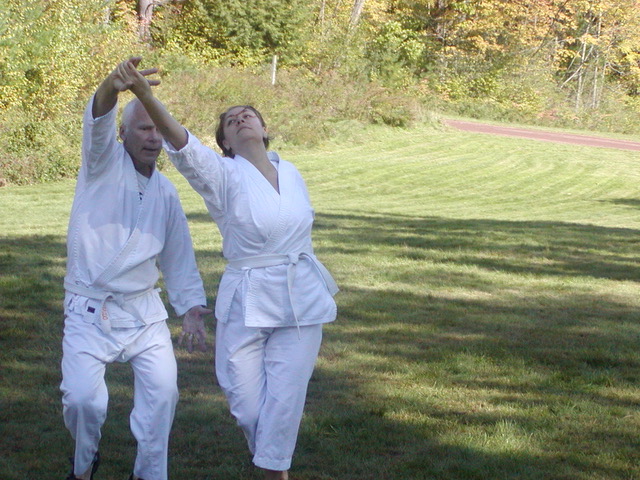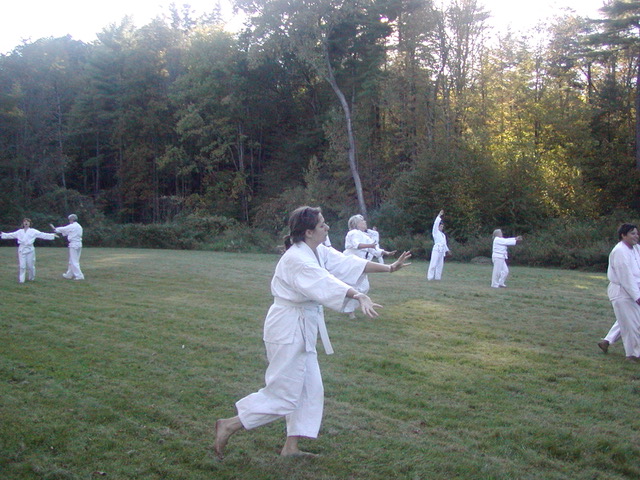by Heather Kuhn
Heather Kuhn has practiced Shintaido for 23 years with the Shintaido North East (SNE) group. Also, she is a somatic psychotherapist who provides individual therapy focused on early life trauma.
As you will read, she is launching a new group Good Enough for Me that integrates Shintaido movements with other expressive arts therapy.

I had been showing up to keiko with increasing fervor for a decade. For ten years, I cultivated the radical resources of pleasure, joy, connection, and yes, a modicum of self esteem. Simultaneously, peeling the many layers of the soma-spiritual defenses I had built up from early life neglect and narcissistic abuse. This required of me leaps of trust, courage, pacing, and apparently, oceans of tears.
The twisted shell I had formed to protect me was challenged, one muddy keiko at a time, until one day I could name what was happening as, gulp, healing. After all, I had come by these unconscious defense strategies all too honestly. They were both the shield I used to avoid grief and the arrows I threw to project my own self loathing.
Through generous gorei, and more than a few sensei willing to hang in there with me, I peeled away these layers, slowly revealing an impossibly soft belly of selfness. I could see with more and more clear how painful it actually was to live that way. I could sense the value of allowing and receiving. I began to plant the seeds of vulnerability as liberation. In a world that trains us to fight each other for scraps and trained me to stay a victim, standing tall while also being soft was nothing short of transformational.
“And the Day Came When the Risk to Remain Tight In a Bud Was More Painful Than the Risk It Took to Blossom.” – Anaïs Nin
As I peered out on the keiko field one Winter morning, I wondered to myself, is movement a recognized avenue for healing from trauma or am I the very first person to discover it? The question that has guided my purpose ever since was born.
And thankfully the simple answer was it absolutely is and no, I am definitively not.
Somatic psychology is a field that studies how our inner galaxies express, reflect, and can be influenced by our embodied awareness, movement, and relationship with our environment, the Earth and universe. It integrates wisdom traditions with grounded research and, more importantly practice to help us understand ourselves, evolve, connect, and heal.
Naturally, I chose to study somatic psychology at Naropa University, where learning is highly experiential, relational, and practice based. Naropa was a collaboration between Chögyam Trungpa and Alan Ginsberg and founded in 1974 on principles combining the wild-creative and Buddhist practice. There are compelling resonances between the Naropa and Shintaido lineages for sure.
While at Naropa, I learned to become what one of my professors calls an attention athlete, as well as how to observe and understand embodied phenomena, facilitate curiosity, and follow the threads of sensation and impulse (among much much more). I saw my studies in Dance/Movement Therapy as an extension of my Shintaido journey and learned to understand what we were up to in our practice, from a psychological perspective, along with strengths, tendencies of bias, and blind spots within it.

I saw myself as an ambassador for our modality, writing several papers integrating Shintaido principles with various therapeutic topics, including attachment theory, catharsis, issues around power and relationship dynamics, and finally in my masters paper about facilitating psychotherapeutic movement in the medium of water.
The program and working with a somatic therapist was what led me the rest of the way to total body connectivity; weaving my inner world with the outer and back again – the building blocks toward the aspiration of self awareness. For four years, I set down my Shintaido practice with an inner commitment to, in part, explore how my psyche was insidiously using my practice to avoid pain. I asked, ‘would I be ok without keiko?’, since I admit that before I began Shintaido, I was not.
I was ok, gratefully, but I discovered Shintaido provided a significant resource for me. Because of my trauma, compensatory practices will likely always be necessary. In other words, the more resilience I can cultivate through practice, the more capacity I will have to fully grieve. The more I can allow grief to move through me willingly, the more access I have to a fulfilling life without the need for defenses.
Fast forward to now. After 23 years of Shintaido, 25 years of meditation practice, 11 years of training in somatic psychology, and 9 years providing individual therapy focused on early life attachment trauma, I am thrilled to announce the launch of a program that integrates Shintaido with the expressive arts therapies to support others on similar paths.
The group is called Good Enough for Me and provides an in-depth process to support adults engaged in healing the lasting effects of childhood emotional neglect, low self-worth, and/or chronic self sabotage. It is a therapy group, complete with an intake process, one-on-one goals honing and check-in sessions, and peer support structures in place. Although there is never-ending depth to explore in Shintaido, the first 10 years of practice provided a universe of curriculum which can be shaped and shared with endless creativity. What might be considered beginning Shintaido is what I am drawing from for this group.
Good Enough for Me has been a dream in the making for 23 years. I’m incredibly proud of the work I have done to be in a place where I can support this vulnerable population and pass along the generosity I was so blessed to receive in our international Shintaido community.
There are a few call outs I would like to make to people without whom I would not have gotten this far. I will never ever forget the time Gianni said “you can do it!” at my side while I did kai kya kusho across the Shintaido farm dojo. It was the first time in my whole life someone said that to me. Or the time David encouraged me to focus on the trying rather than discerning good enoughness. Or how Joe, bless his spirit, would get tearful when he saw me after too long, letting me know I mattered, I belonged, and my presence was wanted. I could go on…
Which is to say, the movements of Shintaido are important, yes, but the opportunities afforded in the movements to help people heal and grow are the real treasures of Shintaido. I believe with all my heart we have something valuable to offer in this time of acute turmoil, volatility, and systemic narcissism.
I invoke Chapter 1 from Shintaido, The body is a message of the universe:
Shintaido is the light in the shade and the sun in the shadow. People who have been constitutionally weak and depressed from birth can discover extraordinary strength and ability through Shintaido. People who have lacked the will power or determination to express even a tenth of their talent can grow and develop in Shintaido. People who have never been aware of their true value will realize the dignity of being. Those who are too self-conscious by nature to express their ideas will find new confidence and conviction. Those whose spirits are closed and stagnant will be inspired with a new faith and purpose. Those who have become private and isolated will be able to communicate a new joy of life to others. Those who are downtrodden or oppressed will understand that all human beings are equal before God and free to express their being. This is why we call our movement Shintaido or “new body way.”
To read more about Good Enough for Me, follow this link.



Thank you Heather and Congratulations! You can do it and you are enough. I appreciate that you are bringing your Shintaido to a larger audience.
Heather
Thank you for your words. There is inspiration you have offered for me to keep practicing and learning Shintaido.